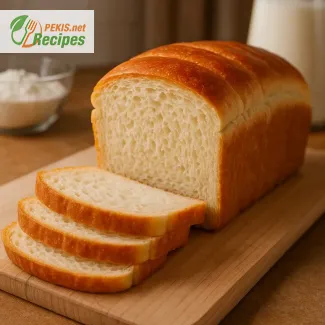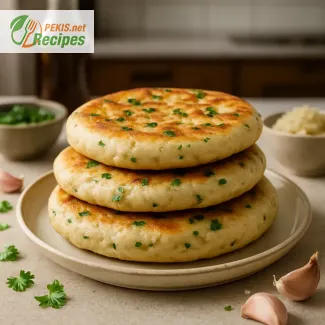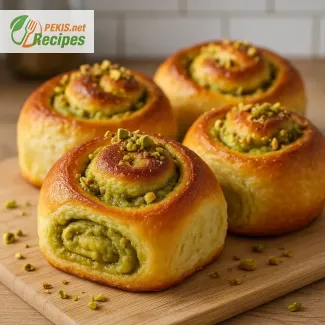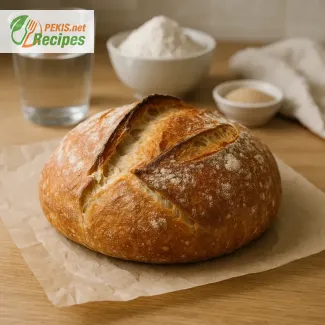
Traditional Slavic Easter Bread with a Fragrant Twist
A rich, soft, and spiced festive loaf that celebrates heritage and spring renewal
Few Easter traditions are as visually stunning and emotionally evocative as the baking of Russian Kulich, a towering, cylindrical sweet bread that fills kitchens with the scent of warm cardamom, citrus zest, and plump raisins. Often crowned with a glossy layer of icing and vibrant sprinkles, this celebratory cake is more than just a dessert—it's a symbol of renewal, hope, and family.
This iconic Slavic Easter bread is deeply rooted in Orthodox Christian traditions, particularly in Russia, Ukraine, and Belarus, where it's baked only once a year to mark Easter Sunday. Its preparation is a labor of love: the dough is enriched with eggs, butter, and milk, then delicately flavored with aromatic spices like cardamom, vanilla, and orange zest, and finally dotted with raisins for bursts of sweetness. The final shape—tall, golden, and domed—resembles a sacred church dome, and its height symbolizes spiritual ascent and joy.
Unlike many Western-style sweet breads, Kulich has a uniquely airy and elastic crumb, more akin to brioche or panettone, making it perfect for slicing and sharing during festive gatherings. It’s traditionally served with a rich dairy spread called Paskha and often blessed in church on Easter morning before being enjoyed at the celebratory table.
The standout quality of this recipe lies in its balance of flavors and textures: the subtle warmth of cardamom, the citrusy brightness, the succulent texture of raisins, and the pillowy-soft interior all come together in perfect harmony. The white icing that drips elegantly down the sides isn’t just decorative—it adds a sweet contrast to the lightly spiced bread and captures the joy of the Easter feast.
For many, baking Kulich is more than a culinary exercise—it's a cherished ritual that spans generations. The rising and baking of the bread often begins the day before Easter, filling homes with warmth and anticipation. Traditionally, the loaves are baked in special tall molds, though modern adaptations use coffee tins or panettone molds to achieve the same distinctive shape. Once cooled, the tops are glazed with a mixture of powdered sugar, lemon juice, and a touch of milk, then decorated with colorful sugar beads or even gilded almonds for a touch of festive opulence.
While classic versions focus on simplicity, today’s interpretations allow for creative personalization: some incorporate candied citrus peel, dried cranberries, or even a splash of rum or brandy in the dough for added depth. But no matter the variation, a well-made Kulich captures the essence of home baking, celebration, and spring’s return.
This particular recipe has been carefully developed to maintain the traditional authenticity of Russian Kulich while also offering clear, practical guidance for home bakers of all skill levels. From choosing the right flour and spices to mastering the rise and achieving the perfect icing drip, every element has been refined to help you create a visually stunning and irresistibly soft Easter bread that will impress both family and guests.
Whether you’re honoring your Slavic roots or simply exploring international holiday traditions, this Russian Kulich with icing is a beautiful centerpiece that brings warmth, nostalgia, and flavor to your Easter table. With its glistening top, golden crumb, and irresistible aroma, it invites everyone to pause, savor, and celebrate the timeless joy of baking and sharing.
- Prepare the raisins: If desired, soak the raisins in rum for 30 minutes to soften and enhance flavor. Drain and pat dry before using.
- Activate the yeast: Warm the milk to about 38°C (100°F). Stir in 1 tablespoon of sugar and the yeast. Let it sit for 10–15 minutes until frothy.
- Mix the dough base: In a large mixing bowl, combine the remaining sugar, softened butter, eggs, and yolks. Beat until smooth. Add in the yeast mixture, vanilla extract, orange zest, cardamom, and salt.
- Add the flour: Gradually add the flour, one cup at a time, mixing until a soft dough forms. Knead for 10–15 minutes until smooth and elastic. Fold in the raisins.
- First rise: Place the dough in a lightly oiled bowl. Cover with a clean cloth and let rise in a warm area for about 1.5 hours or until doubled in size.
- Shape and second rise: Lightly grease a tall baking mold (panettone mold or coffee can). Punch down the dough and shape it into a ball. Place into the mold and let rise again for 30–45 minutes, until the dough reaches near the top of the mold.
- Bake: Preheat oven to 180°C (350°F). Bake the Kulich for 40–45 minutes. If the top browns too quickly, tent it with foil. The bread is done when a skewer inserted into the center comes out clean.
- Cool and glaze: Allow the Kulich to cool in the mold for 15 minutes, then remove and cool completely on a wire rack. Whisk together powdered sugar, lemon juice, and milk until smooth. Drizzle over the top of the cooled Kulich, allowing it to drip down the sides. Decorate with sprinkles.
Creative Upgrades for the Classic Russian Kulich
Elevating tradition with thoughtful adjustments, healthier ingredients, and expert techniques
The beloved Russian Kulich has stood the test of time as an iconic symbol of Easter celebration. However, even the most treasured traditional recipes can benefit from subtle modern improvements that enhance both flavor and texture, or offer alternatives for health-conscious bakers. From refining the choice of ingredients to avoiding common preparation pitfalls, there are many ways to transform this classic sweet bread into something even more spectacular—without losing its soulful heritage.
Subtle changes that enhance taste and aroma
One of the most effective ways to intensify the flavor of Kulich is through the thoughtful use of aromatic ingredients. While traditional recipes include cardamom, vanilla, and citrus zest, incorporating freshly ground spices can significantly deepen the sensory experience. Freshly grated nutmeg (½ tsp) or a pinch of ground clove will add warm, earthy undertones, while rose water or orange blossom water (1–2 tsp) can introduce a delicate floral note that elevates the festive character.
For a richer mouthfeel, replace part of the milk with heavy cream or evaporated milk. This will yield a softer, more buttery crumb, especially when combined with high-fat European-style butter. Swapping standard sugar for light brown sugar or muscovado sugar can contribute caramel-like depth and increased moisture retention.
Enriching the dough for added complexity
To create a more luxurious texture, consider incorporating sour cream (2 tbsp) or Greek yogurt into the dough. These additions improve elasticity and give the bread a slightly tangy aftertaste, balancing the sweetness of the icing and raisins.
Adding candied orange or lemon peel (30–50 g) introduces pleasant bursts of flavor and a slight chew that complements the softness of the crumb. For an adult twist, soaking the raisins in rum, Grand Marnier, or Amaretto enhances their sweetness and adds complexity to the overall taste.
Nutritional upgrades and healthier variations
For those seeking a more health-conscious version, several ingredient substitutions can maintain the traditional character while reducing the calorie load or increasing nutritional value. Replace part of the white flour with whole wheat flour (up to 25%) to add fiber and nutrients without compromising the texture.
Substitute refined sugar with coconut sugar or maple syrup (adjusting the liquid content slightly) to lower the glycemic index and introduce natural sweetness. For the icing, a mix of Greek yogurt and honey can serve as a lighter alternative to the traditional sugar glaze.
Switching to plant-based milk (like almond or oat milk) and vegan butter allows for a dairy-free version. For an egg-free Kulich, use flaxseed meal (1 tbsp flax + 3 tbsp water per egg), though results will be slightly denser.
Common mistakes and how to avoid them
Even experienced bakers can encounter issues when preparing Kulich. One of the most common errors is overproofing the dough, which causes it to collapse or crack during baking. Always monitor the rise closely—when the dough reaches just below the rim of the mold, it's time to bake.
Another frequent problem is dry texture, often due to overbaking or insufficient moisture in the dough. Use an oven thermometer for accurate temperature control, and consider placing a pan of water on the oven floor to create steam, which helps maintain moisture.
When incorporating raisins or other dried fruits, make sure they’re fully dried after soaking to avoid excess liquid in the dough, which can affect structure and rising.
Enhancing presentation and festive appeal
While flavor is king, visual appeal plays a significant role in how Kulich is received. Instead of using simple sugar sprinkles, try decorating the glaze with edible flowers, crushed pistachios, or dehydrated citrus slices for a refined touch.
To ensure a professional-looking glaze, wait until the bread is completely cool before icing. A slightly thicker glaze (with less milk) creates defined drips that set beautifully.
You can also bake miniature Kulich loaves using muffin tins or smaller molds, which are ideal for gifting or individual servings at the Easter table.
Why homemade is always better
The magic of homemade Kulich lies not only in its superior taste and freshness, but also in the emotional resonance it carries. Unlike store-bought versions, which often rely on preservatives and artificial flavorings, homemade Kulich is crafted with care, using natural ingredients and personal touches that connect generations.
The experience of kneading, rising, shaping, and decorating the bread becomes a ritual in itself—one that brings joy, teaches patience, and strengthens family traditions. Every hand-made Kulich tells a story, and that story continues to grow each year it's passed down.
Seasonal inspiration and global fusion ideas
For those looking to blend cultures or add a unique spin, consider integrating matcha powder for a subtle tea flavor and vibrant green hue, or replace raisins with dried cherries, figs, or goji berries for a global twist. A swirl of cocoa powder and cinnamon can transform the traditional Kulich into a marbled delight.
Alternatively, try adding crushed nuts like hazelnuts, almonds, or pecans into the dough for added texture and a nutty aroma that complements the sweetness of the bread.
You can also experiment with herb-infused glazes, like lemon-thyme or vanilla-lavender, which add an aromatic flourish without overwhelming the Kulich’s delicate flavor profile.
Improving the traditional Russian Kulich doesn’t mean abandoning its roots. On the contrary, it’s about embracing the essence of this treasured bread while exploring new possibilities that suit your tastes, dietary needs, and culinary creativity. Whether it’s through upgraded ingredients, healthier swaps, or inventive decorations, each variation adds a new layer of meaning to a timeless recipe—making every Easter celebration all the more special.
Allergens and gluten:
- Contains gluten (from all-purpose flour)
- Contains eggs, milk, and butter
Allergy substitutions:
- For gluten-free: Use a 1:1 gluten-free flour blend with xanthan gum. Rising may vary slightly.
- For dairy-free: Replace milk with almond milk and butter with vegan butter.
- For egg-free: Use egg replacement powder or a mix of water and ground flaxseeds (1 tbsp flax + 3 tbsp water per egg).
- Vitamin A: 160 µg – supports vision and immune health
- Vitamin D: 0.5 µg – supports bone health
- Vitamin B12: 0.4 µg – essential for red blood cell formation
- Iron: 1.8 mg – helps oxygen transport in the blood
- Calcium: 45 mg – important for bone structure
- Magnesium: 15 mg – supports muscle and nerve function
- Potassium: 130 mg – helps regulate fluid balance and nerve signals
- Phosphorus: 80 mg – needed for strong bones and teeth
- Vitamin E: 0.9 mg – protects cells from oxidative damage
- Flavonoids (from raisins): ~20 mg – support heart and vascular health
- Carotenoids (from egg yolks): ~50 µg – promote eye health and protect against inflammation





